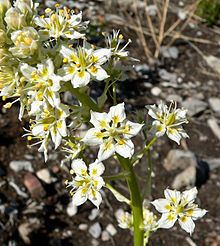Rank Species | ||
 | ||
Similar Toxicoscordion, Toxicoscordion venenosum, Zigadenus, Toxicoscordion fremontii, Anticlea | ||
Toxicoscordion paniculatum is a species of flowering plant known by the common names foothill deathcamas and sand-corn. It is widely distributed across much of the western United States, especially in the mountains and deserts of the Great Basin region west of the Rocky Mountains. It grows in many types of habitat, including sagebrush plateau, grasslands, forests, and woodlands, etc.
Toxicoscordion paniculatum is a perennial wildflower growing from a brown or black bulb up to 5 centimeters long by 3 wide. The stem grows up to 70 centimeters long. The leaves are linear in shape, measuring up to 50 centimeters long. Most of the leaves are at the base of the stem and there may be a few reduced leaves above. The inflorescence is an open panicle of flowers, becoming dense at the tip. The panicle contains up to 80 flowers, most of which are bisexual; some flowers at the end of branches and near the base of the panicle are only staminate (male), or are sterile. Each flower has six tepals, the inner three being slightly larger than the outer, measuring about 3 to 6 millimeters in length. The tepals are cream-colored, each with a yellowish green gland at the base. The fruit is a capsule 1 or 2 centimeters long.
This plant is toxic to animals, but livestock generally avoid it because it is unpalatable. Cases of human poisoning by ingestion of the bulbs have been documented as well.
